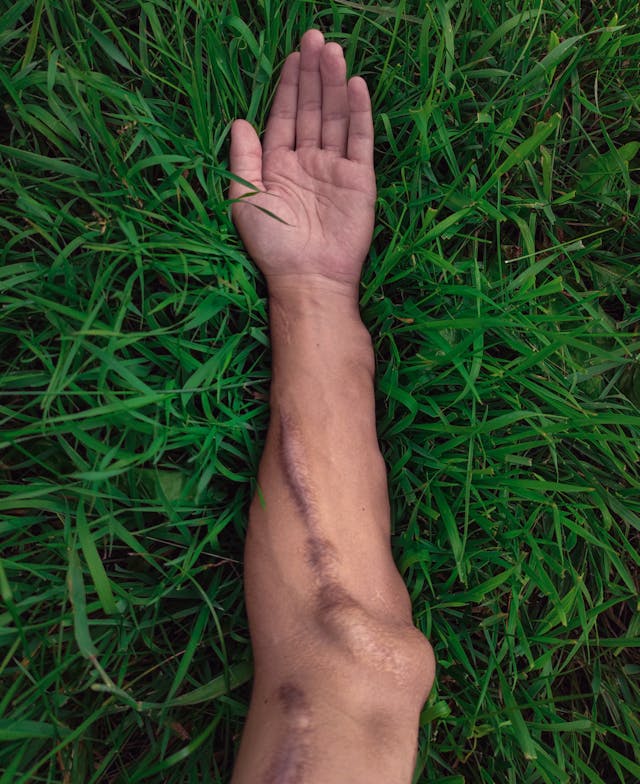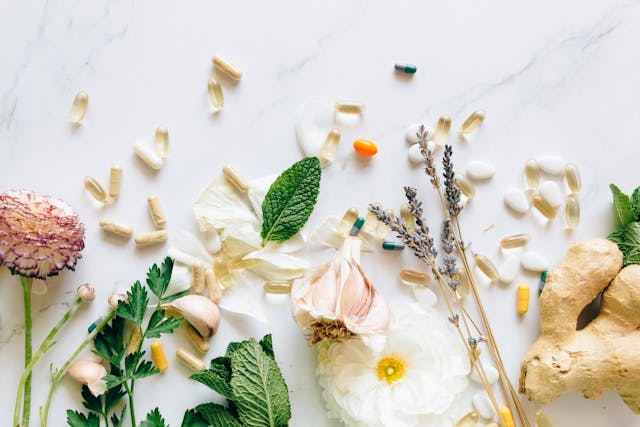Before talking about home remedies for keloids we have to know what keloids are.
Keloids are abnormal, raised scars that grow larger than the original wound.
They are formed due to an overgrowth of collagen in the skin during the healing process of an injury.
Unlike typical scars, keloids extend beyond the original wound boundaries and can continue growing over time.
Keloids can develop on any part of the body but are commonly found on the chest, shoulders, earlobes, and cheeks.
Keloids may cause self-consciousness and anxiety, especially if they are prominent or located in visible areas of the body.

Keloids symptoms
Keloids extend beyond the injury site, forming a raised area of skin that may be itchy.
In some cases, keloids can be painful to the touch, especially if they are large.
Keloids may appear darker or lighter than the surrounding skin, depending on the individual's skin tone and pigmentation.

Causes of keloids
Deep wound
During the process of healing from an injury, some bodies produce an excessive amount of collagen, which leads to the formation of keloids.
Chickenpox
It can lead to skin lesions and eventual scarring.
Keloids develop as a result of the individual's skin healing response, not directly from the chickenpox virus.
Piercings
After getting a piercing, keloids may form on the earlobes. so you have to take care of it.
Tattoos
Keloids may be formed around the tattoo.
Acne
Leaving your acne untreated for a long time can lead to the formation of keloids around the acne scars.
People with a high risk of keloids
Asians, Africans, and Latin Americans have the highest risk of developing keloids.
The formation of keloids is strongly influenced by family history, with over 50% of patients having a family history of injury with keloids.
Also, keloids are common between the ages of 10 and 30 years old.
Diagnosis of keloids
Physicians can detect the keloid from its appearance like their shape, color, and degree of protrusion.
Then ask the patient about his history like asking about surgery.
But if it isn’t obvious, physicians recommend a skin biopsy.
Home remedies for keloids
Aloe vera
One of the most common home remedies for keloids aloe vera, has a soothing and anti-inflammatory effect.
It is recommended for a variety of skin conditions, including keloid scars.
The gel in the aloe plant reduces skin inflammation and improves the appearance of scars by moisturizing the skin.
We get aloe vera gel by cutting aloe vera leaf and extracting gel from it.
Then apply it to the keloid scar and we can leave it on the skin.
Honey
As home remedies for keloids, it’s known that honey has antibacterial and anti-inflammatory effects.
So we use honey to heal wounds and reduce inflammation.
The recommended method is to apply honey to the keloid scar for 30 minutes then rinse it with water.
Apple cider vinegar
Another one of the home remedies for keloids is apple cider vinegar.
Which has the acidic nature of vinegar which helps reduce the size and redness of keloids over time.
It's used by diluting apple cider vinegar with water and applying the mixture to the keloid for 30 minutes then rinsing it with water.
Tea tree oil
Tea tree oil possesses antimicrobial properties and assists in reducing inflammation by applying 3:4 drops of tea tree oil to the keloid and leaving it overnight.
Onion extract
One of the home remedies for keloids may help reduce the size of keloids and enhance the appearance of keloids.
We can make onion juice by blending it and then applying it to the keloid or we can find onion extract in creams and gels.
Sandalwood and rosewater
That mixture of home remedies for keloids has anti-inflammatory and regenerating properties.
It reduces inflammation, itching, and the size of the keloid.
This method is by mixing sandalwood powder with water, applying it to the keloid then leaving it overnight and washing it in the morning.
Lemon juice
It is well known for its natural antioxidant properties due to its high vitamin C content.
Lemon juice may help lighten skin pigmentation caused by keloids.
But home remedies for keloids like applying lemon juice directly to the skin can be irritating and may worsen the keloid scar.
The recommended application method is to apply lemon juice to the affected area.
Leave it on for 30 minutes, and then wash the area with warm water. this method twice a day.

In failure home remedies for keloids
Silicone gel sheets
They help flatten the keloid over time, they are available over the counter.
It is preferred to apply it early to prevent keloid from developing, but don’t use silicon gel on open wounds.
Studies have shown a 90% reduction in keloid scars with silicone gel sheeting and a decrease in keloid and hypertrophic scar rates after surgery.
Injection of corticosteroids
Corticosteroids can help reduce inflammation and flatten the keloid.
Keloid surgery
Cutting out the keloids but they return after the surgery.
So there is treatment after the surgery such as Wearing a pressure garment or getting cryosurgery to help decrease the risk of a keloid returning.
This ordinary method of management is not recommended because many are recurrent.
Laser therapy
Lasers work by targeting the excess collagen in the keloid tissue.
They can help to flatten, reduce the redness of the keloid, and enhance the appearance of the keloid scar.
Laser therapy is often combined with other treatments such as steroid injections.
Or pressure therapy to enhance effectiveness and reduce the risk of recurrence.
Cryotherapy
Cryotherapy is freezing the keloid tissue with liquid nitrogen or another freezing agent that causes the tissue to die.
It works by destroying the abnormal collagen fibers that make up the keloid tissue.
This helps to flatten the keloid and reduce its size.
In conclusion, we discuss the keloids that take months to manage.
It’s necessary to treat our injuries early as keloid may appear while the wound is healing and growing if you leave it untreated.
According to the case of keloids, the management is determined.
As we know we can use home remedies for keloids as aloe vera, honey, and onion extract to decrease keloid symptoms, not the main treatment to get rid of keloids.
Read more about:


You must be logged in to post a comment.